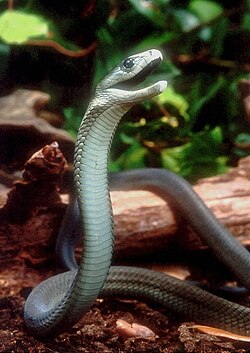Black mamba
The black mamba (Dendroaspis polylepis) belongs to the Elapidae family of snakes. It is the second largest venomous snake in the world. An adult black mamba can grow up to 14 feet (4.3 m) in length.[2] The black mamba's skin is not actually black, it gets its name from the colour of the roof of its mouth.
| Black mamba | |
|---|---|

| |
| The black mamba | |
| Conservation status | |
| Scientific classification | |
| Kingdom: | |
| Class: | |
| Order: | |
| Suborder: | |
| Family: | |
| Genus: | |
| Binomial name | |
| Dendroaspis polylepis Günther, 1864
| |
The black mamba lives in the south and the east of Africa. It is known around the world for its dangerous venom. It is very fast (it reaches speeds of 12 miles per hour) and can also climb very fast. The black mamba lives 10-11 years.
Habitat
Black mambas enjoy rock-covered hills, forested savannah, and woods with rocks and fallen trees to shelter them. They also can be found in hollow trees and in termite mounds. If the black mamba is not disturbed, it will come back to a certain home all its life. They are typically found in subsaharan places in parts of south and east Africa. They can be found as far north as Eritrea, and as far west as Namibia, and in South Africa.
Prey
Black mambas eat small mammals like rodents, squirrels and bush babies. Sometimes they eat birds. They bite once or twice and then wait for their prey to become paralyzed and die. Then they eat them.
Predators
There is not much information on the predators of the black mamba, but snakes have many predators. Some predators are birds of prey, crocodiles, big frogs, mongooses, monitor lizards, foxes, jackals, and even humans. Snake eggs are sometimes eaten by scavengers. The Black Mamba is timid and does not strike unless threatened.
Behavior
The black mamba is a shy animal. They like to avoid other animals, but if another animal confronts them, they become aggressive. When the black mamba is threatened, it will raise its head, open its mouth, expand its hood, and flick its tongue. It will also hiss. Its bites are fast and it bites many times. Its venom can be fatal to humans. The black mamba likes to bask in the sun, and it remembers the spot it basks at. They are fast and can climb trees quickly.
They communicate in the same ways that most snakes do. They use their eyes to detect motion, and if it is sudden they will attack. They 'see' with their tongue by collecting air particles and then putting them on an organ in their mouth. The organ senses what is around them with the air particles. They do not have ears on the outside of their body, but they can sense vibrations in the ground. Like many other snakes, if they are threatened, they will show aggression and signals that warn the attacker.
Venom
A black mamba's bite is easily potent enough to kill many adult men. The deadly venom takes between 30 minutes to 3 hours to kill, in most cases.[3] Unlike most snakes it has enough venom to bite many times in a short period. A black mamba usually attacks the head of its prey if possible. This is so it can kill its prey easily. For this reason a black mamba can raise itself to a height of almost four feet.[3]
Reproduction
When the males and females are done mating, they go back to their homes. In two to three months the females will lay 6-17 eggs, which will hatch in 2-3 months. Black mambas do not interact with each other besides mating. They do not try to raise their young. When the female lays her eggs, she will put them in a safe place and leave them. The babies have to defend themselves from birth. Young black mambas stay in the egg for 2-3 months, and then they break through the shell with an 'egg tooth.' They are almost fully developed when they hatch, and they already have venom glands and can defend themselves mere minutes after their birth. Black mambas mate in the early springtime. The male snakes will find a female by following their scent. When the male black mamba finds the female, he will inspect her with his tongue. Male snakes will fight a lot during the mating season. They intertwine their bodies and raise their heads up to one meter off the ground. It looks like dancing.
Related species
The black mamba is related to all members of the elapidae family
Black Mamba Media
Juvenile in a tree, Kruger National Park, South Africa
References
- ↑ Dendroaspis polylepis[dead link] at the IUCN Red List
- ↑ "National Geographic Mamba profile".
- ↑ 3.0 3.1 "Deadly snakes of Africa". Archived from the original on 2008-09-13. Retrieved 2008-09-06.
- Krysko, Kenneth L. Mamba. World Book Advanced. World Book, n.d.
- Schott, Randy. Dendroaspis polylepis - black mamba. Animal Diversity Web. University of Michigan, 2005.




